DSL
Combined FTTH and DSL spending set to slow until 10 Gbps PON and G.fast deployments
By Jeff Heynen of SNL Kagan
After a record year in which total estimated revenue for combined digital subscriber line, or DSL, and fiber-to-the-home, or FTTH, network infrastructure reached $9.77 billion worldwide, 2017-2019 should produce a slowdown in spending. Kagan, a media research group within S&P Global Market Intelligence, is forecasting a trough being driven by expected slowdowns in 1G EPON and 2.5G gigabit passive optical networks (GPON) spending as operators wait for 10Gig technologies, including XGS-PON to become more widely available. Equipment revenue is expected to drop to $9.43 billion in 2017, $8.98 billion in 2018 and $8.80 billion in 2019, as optical line terminal, or OLT, purchases for network expansion slow and prices for current-generation technologies continue to decline.
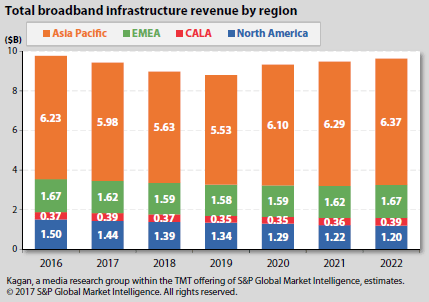
The vast majority of revenue will continue to come from the APAC region, specifically China, where China Telecom Corp. Ltd., China Unicom and China Mobile benefit from favorable regulatory policies designed to reduce FTTH construction and installation costs to help achieve national penetration and average bandwidth per user goals. Of the 95 million FTTH optical network termination, or ONT, units shipped in 2016 throughout the APAC region, we estimate that 83.5 (80.1 million) shipped to China. We expect total ONT shipments to the main Chinese operators will continue to stay in the 75 million to 80 million range through 2020, as the operators look to replace aging units with more integrated gateway units.
North American FTTH equipment spending was up 30% in 2016, surpassing $1.12 billion in equipment revenue, a first for the region and an indisputable challenge to the assertion that broadband spending in the region has declined. Total spending in North America was driven by 2.5G GPON equipment purchases at Verizon Communications Inc., AT&T Inc., Alphabet Inc.‘s Google Fiber and a growing number of tier 3 operators. Demand for new equipment is being driven primarily by Verizon, which is adding new FiOS subscribers and updating older GPON ONT models, and AT&T, which continues to expand its GPON-based AT&T Fiber footprint. But other operators, including CenturyLink Inc., Windstream Holdings Inc., Frontier Communications Corp. and Telephone and Data Systems Inc., continue to transition a growing percentage of their network footprint to fiber. However, we do believe that some of these initiatives, particularly Verizon’s FiOS upgrades, will slow after the peak in 2016, pushing revenue down to $1.07 billion in 2017 and $999.4 million in 2018.
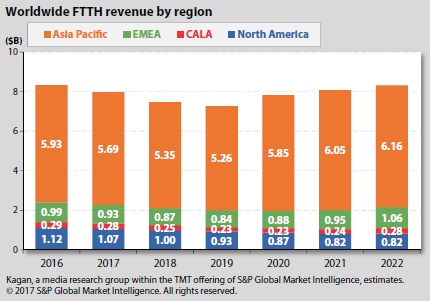
2.5G GPON remains the workhorse FTTH technology on a global basis, with operators including Verizon, AT&T, China Telecom, China Mobile, China Unicom, Telefónica S.A. and many others relying on the technology for their residential FTTH deployments. We expect 2.5G GPON will remain the leading technology choice through 2021, as ONT shipments to support subscriber growth on existing networks remain high, despite the increased rollouts of XGS-PON and NG-PON2 technologies over time.
Saturation, waiting on 10G, and a focus on 5G will keep revenue growth in check
Though 2016 was a strong year for FTTH equipment revenue, it is likely to be the peak throughout our forecast period. In 2017, revenue is expected to decline from $8.33 billion to just under $8 billion. Chinese operators are expected to slightly slow their OLT rollouts after seven straight years of phenomenal growth. Their focus will be less on new FTTH network expansion and more on continued subscriber acquisition, which will result in continued spending on ONT units. Also, the three main Chinese operators will be rolling out 10G EPON and 10G GPON equipment, as they wait on XGS-PON equipment availability. The focus will be on improving bandwidth in major metropolitan areas, especially among subscribers currently served by fiber-to-the-building (FTTB) + local area network (LAN) architectures, which typically max out at 10 Mbps downstream.
In North America and Western Europe, FTTH network buildouts, measured in the number of new OLT ports shipped, will slow after 2018, when a combination of factors are expected to reduce overall investment levels:
* Many operators will have reached saturation levels within their core FTTH networks. Like Verizon, these operators will hold off on additional territory expansions and instead focus on securing subscribers within their existing serving areas. The net result will be declining OLT shipments and sustained ONT unit shipments.
* Operators will wait until 10G variants of PON technologies become more widely available and therefore less expensive, particularly 10G EPON for cable operators, XGS-PON, which delivers symmetric 10 Gbps of throughput and NGPON-2, which delivers up to 40 Gbps of symmetric throughput.
* Finally, operators will begin shifting their spending toward preparing for upcoming 5G wireless networks. The early stages of 5G network buildouts will focus on metro areas and will rely on existing fiber connections for backhaul purposes.
Beginning in 2020, overall spending on FTTH equipment is expected to pick back up, based on increased shipments of 10G EPON, XGS-PON and NGPON-2 equipment to support upgrades to first-generation FTTH networks, business services and the backhaul of 5G wireless network traffic. By 2022, we expect total FTTH equipment spending to be $8.32 billion, nearly equal to the 2016 peak.
In a change from our October forecast, we now expect XGS-PON to become the leading next-generation technology during our current forecast period. Previously, we had expected that NGPON-2, driven by anticipated deployments at Verizon, China Telecom, and others would become the leading next-generation technology. However, after conversations with service providers, equipment vendors and component suppliers, we do not see NGPON-2 equipment, with its reliance on expensive, tunable optics, becoming widely deployed for FTTH applications until 2021 and beyond.
In our previous forecast, we expected worldwide revenue for NGPON-2 equipment in 2021 to reach $2.20 billion. We now expect it to reach just over $1 billion in 2021, with much of the revenue coming from Verizon, as it upgrades its FiOS network. By 2021, portions of Verizon’s FiOS network will be over a decade old. And with cable operators’ aggressive deployments of DOCSIS 3.1 technologies, Verizon will be forced to switch to NGPON-2 to provide a bandwidth advantage for the next decade. In addition, Verizon is expected to rely on NGPON-2’s ability to deliver multiple wavelengths to support the backhaul of mobile data traffic from its 5G base stations. A single NGPON-2 OLT can theoretically split multiple wavelengths for residential services, mobile backhaul and business services.
While Verizon is expected to stick with its plan to move to NGPON-2, a larger number of operators around the world will opt for XGS-PON, beginning in late 2017, but picking up steam in 2019. XGS-PON uses fixed optics and wavelengths, like current GPON technologies, but also provides an upgrade path to tunable optics for operators that want to move to NGPON-2 down the road.
Many operators have a 5-year goal of getting symmetric 10 Gbps services out to their customers, which would provide them an edge over cable competitors who will likely be stuck with asymmetric services through at least 2020, when full duplex DOCSIS 3.1 equipment becomes available. XGS-PON gives them the ability to deliver symmetric 10 Gbps services at price levels that are currently 4x 2.5G GPON equipment prices, as opposed to the minimum 10x 2.5G GPON costs currently seen for NGPON-2 equipment. FTTH is an expensive proposition as-is, with labor and operational costs generally consuming 70% of the budget. Equipment costs have to be controlled in order to ensure reasonable payback periods for network operators. Right now and for at least the next two years, NGPON-2 equipment will simply be too much cost to bear for most operators. Hence, the growing interest in XGS-PON among operators including AT&T, China Telecom and a growing list of tier 2 and tier 3 operators globally.
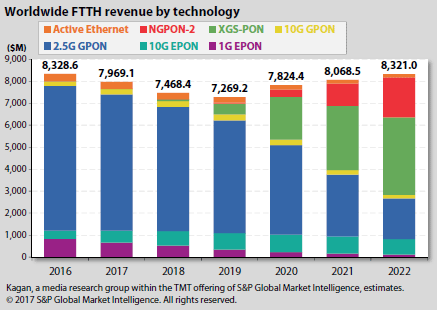
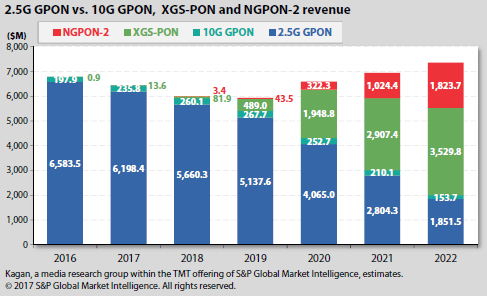
For operators with 1G EPON-based deployments — particularly Korea Telecom, Japan‘s NTT DOCOMO access, China Telecom and China Unicom, 10G EPON is quickly becoming the next-generation technology of choice for providing both asymmetric and symmetric 10 Gbps services. 10G EPON equipment shipments and revenue continue to grow, driven currently by China Telecom, which is in the process of upgrading a portion of its first-generation 1G networks to provide more bandwidth to multi-dwelling units, or MDUs.
Longer-term, cable operators in North America and Western Europe will deploy 10G EPON in Greenfield deployments and, on occasion, in overbuild situations, as well as for business services. Of course, MSOs will rely heavily on DOCSIS 3.1 for the bulk of their residential deployments. But 10G EPON will also be an important technology for cable operators for MDU deployments and business services, particularly as fiber is pushed deeper into the network and remote nodes are converted into OLTs.
Our equipment revenue forecasts for 10G EPON have been nearly doubled, due largely to higher-than-expected spending levels seen in 2016 in China, but also due to our expectations that a growing number of cable operators will mix in a higher percentage of 10G EPON for greenfield FTTH buildouts. Altice USA, Inc. has already committed to a full FTTH network buildout across its footprint, which we have now factored into our forecasts. In addition, we expect other North American MSOs to slowly migrate to 10G EPON for both their business and greenfield residential access networks.
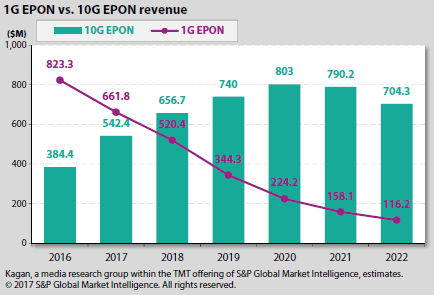
VDSL and G.fast spending to sustain DSL infrastructure market through 2019
Global spending on DSL equipment by operators and ISPs is expected to increase by 1.4% this year, with 2017 equipment revenue now expected to rise to $1.46 billion. The primary reason for the increase is a resumption in spending in the CALA region, which saw 2016 equipment revenue plummet to $75.8 million. Economic uncertainty in the region, as well as a decision by Telmex to halt its VDSL rollouts helped to push revenue down sharply in the region. We now expect DSL spending to reach normal annual levels, with 2017 revenue to reach $117.5 million.
Outside of CALA, declines are once again expected this year in North America, where total DSL revenue is expected to drop from $388.3 million in 2016 to $368.9 million in 2017. AT&T’s continued shift for its U-Verse service from very high bit rate digital subscriber line generation 2 (VDSL2) GPON is expected to result in a decline of another 600,000 VDSL ports from 2016 to 2017.
EMEA remains the world’s largest market for DSL infrastructure: 47.2% of global revenue comes from this region, where incumbents such as British Telecom (BT), Deutsche Telekom AG (DT), Orange SA, Telefonica and others continue to rely on asymmetric digital subscriber line (ADSL) and VDSL technologies for the bulk of their residential broadband service offerings. Providers have shifted a small percentage of their broadband networks to FTTH and will continue to do so. However, the cost of widespread fiber deployments, as well as line-sharing obligations will keep the bulk of broadband connections in this region copper-based. Throughout our forecast, the EMEA region will constitute 46% to 48% of global DSL revenue and will continue to be the leading region for G.fast deployments.
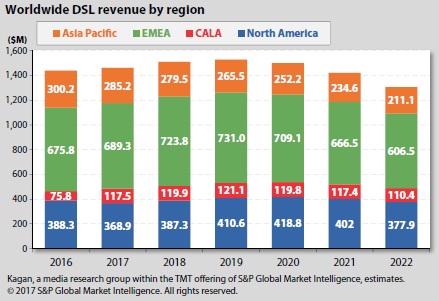
Along with the revenue increase expected in 2017, total DSL ports should also increase from 54.8 million in 2016 to 58.3 million. Further increases in total ports are expected through 2020, as service providers continue to shift away from ADSL/ADSL2+ technologies to VDSL2, VDSL Profile 35b and G.fast. From 2021 forward, however, we do expect the total market for DSL ports will decline, as more operators switch to FTTH as a logical progression from their deep fiber deployments to support VDSL2 and G.fast deployments.
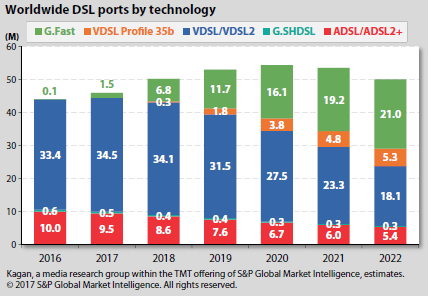
G.fast, a high-frequency DSL protocol designed for copper loops of 250 meters that can deliver between 150 Mbps and 1Gbps, will be relied upon by BT, Orange, Telekom Austria Group, AT&T and others in the coming years. CenturyLink already announced a 44-building G.fast deployment in Platteville, Wis. CenturyLink is expected to continue its G.fast deployments throughout 2017 and beyond. But BT is expected to drive the most G.fast port and customer premises equipment (CPE) shipments, with its announced plan to pass 10 million homes with G.fast by 2020.
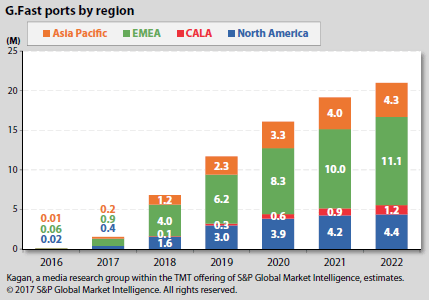
Until G.fast silicon chips, infrastructure and compatible CPE products are available in volume, VDSL2 will remain the workhorse technology. Vectored VDSL2 can provide 100 Mbps to 150 Mbps service over copper loops of 500 meters and has been used by a large number of operators in North America, EMEA and CALA to remain competitive with fiber over builders and cable operators.
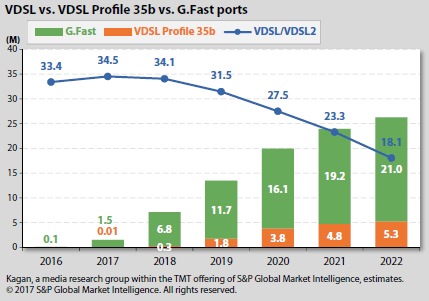
VDSL profile 35b, alternately called Super VDSL or Vplus, provides a niche solution between vectored VDSL2 and G.fast. At loop lengths between 250 and 500 meters, VDSL profile 35b can provide speeds ranging from 200 Mbps to 300 Mbps. Germany‘s DT is the leading proponent of this technology, as the operator has yet to deploy a significant amount of vectored VDSL2 and can therefore more cost-effectively make the transition to the 30 MHz vectoring of profile 35b. Additionally, DT has a large percentage of copper lengths within the 250 to 500 meter range, making it the ideal target for this technology.
Reference:
Residential Broadband: Fiber Access Now #1; Deep Fiber Penetration; Wireless Substitution & Forecasts
Fiber Tops DSL for Fixed Broadband Access:
Fiber has surpassed DSL as the most common fixed broadband access type, accounting for 43.2% of the global market, market research firm SNL Kagan wrote in a recently released market research report (subscription required). Kagan is a unit of S&P Global Intelligence.
Growth in fiber network deployment rose a sharp 55.6% worldwide year over year in 2016, putting fixed broadband connections on track to reach 1 billion subscriber lines by year-end 2021, a five-year CAGR of 5.2 %, Kagan wrote.
Note: It’s not clear if the fiber numbers cited by Kagan are based on FTTH via GPON, optical Ethernet or other technology such as hybrid fiber-copper/coax. Please see quotes below on deep fiber penetration from Jeff Heynen.
……………………………………………………………………………………………….
In contrast, the global DSL market (ADSL, VDSL, SHDSL, etc) registered a 32% gain, according to Kagan’s data.
China and the U.S., respectively, are the two largest fixed broadband markets, accounting for 46.9% of the worldwide total in 2016. China alone accounts for 34.7% of the global total, and fixed broadband connections increased 45.7% in 2016 as Chinese providers continue to follow through on the central government’s Broadband China initiative.
In addition to a growing FTTH footprint in the U.S., fiber-connected commercial buildings are on the rise as well. The number of fiber-connected commercial buildings in the U.S. soared 49.6 percent year-to-year in 2016, according to the latest market data from Vertical Systems Group.
Nine in 10 U.S. commercial buildings lacked fiber network access back in 2004. That dropped to 50.4% last year.
Source: Article by Andrew Burger of Telecompetitor
……………………………………………………………………………………….
Telcos Transition to Deep Fiber Technologies & G.fast:
Jeff Heynen of SP Global Market Intelligence wrote in a recent blog post:
“The need to compete with cable gigabit service rollouts has forced telcos globally to shift spending on traditional ADSL and VDSL modems and gateways to units supporting deep fiber technologies, including fiber-to-the-home, or FTTH, and G.fast. The lone copper-based technology expected to see significant unit growth, G.fast, is forecast to jump from 825,500 units in 2017 to nearly 18 million units in 2022. In 2017, G.fast units are expected to represent just 1% of total DSL customer premises equipment, or CPE shipments. But by 2022, G.fast units, with the promise of faster speeds on traditional copper loops, are forecast to represent 31% of the total market. British Telecom (BT) should drive the most CPE shipments, with its announced plan to pass 10 million homes with G.fast by 2020. Beyond BT, Orange SA, AT&T Inc., CenturyLink Inc., Telekom Austria Group, Chunghwa Telecom and Israel’s Bezeq are expected to rely on G.fast for both single-family and multi-dwelling unit (MDU) deployments.”
Regarding AT&T’s announce move from VDSL2 to PON for it’s U-verse triple play service bundle, Heynen wrote:
“AT&T remains a major wildcard in the deployment of G.fast. Though the company has been firmly committed to shifting from its VDSL2-based U-Verse to Gigabit passive optical network (GPON)-based AT&T Fiber, the question is just how much of its existing U-Verse footprint will move to G.fast as opposed to full FTTH. Our expectation is that AT&T will use G.fast in certain residential markets, particularly MDUs and townhomes where G.fast can be deployed to address more than eight residences from a single DPU.”
…………………………………………………………………………………………
Residential Broadband Forecast by SNL Kagan:
Broadband subscriptions are on track to surpass 80% of U.S. households in 2017 and enjoy growing appeal in the five-year outlook. However, like the U.S. multichannel segment before it, the shadow of cord cutting threatens to darken service providers’ doorways in the extended forecast.
Residential high-speed data subscriptions are expected to crest the 100 million mark by the end of 2017 and hit 106.7 million by 2021, according the latest forecast from Kagan, a media research group within S&P Global Market Intelligence.
In the process, primary residential broadband connections from cable, telco, wireless and satellite services would reach nearly 84% of occupied households. While the appeal of broadband connections is not expected to lose its shine, the growth opportunity for wireline services faces limitations because of a consumer migration to wireless-only configurations.
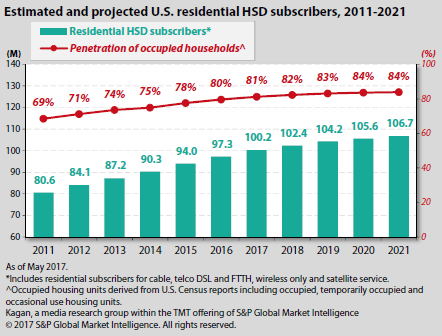
Chart Courtesy of SNL Kagan
………………………………………………………………………………………..
Kagan’s revised outlook includes assumptions for an intensification of wireless competition, ramping up in 2020 and 2021 behind broader availability of 5G. However, the outlook still anticipates a reliance on wireline broadband for the majority of households as incumbent providers combat the lure of Internet cord cutting. The factors supporting confidence in wireline broadband include:
* Increasing speeds and monthly throughput — Wireline providers have consistently boosted speeds year over year with no sign of a ceiling.
* Greater in-home integration — Service providers are reaching beyond the three-product bundle to serve as home integrators of connectivity and other enhancements.
* Price competition — ISPs have capitalized on pricing headroom to boost rates and increase revenue but the thick HSD margins provide room to combat wireless replacement with more competitive prices.
* Interlocking fixed and wireless broadband packages — 5G’s reliance on dense local wireline networks for backhaul of the small cell architectures offers an opportunity for wireline providers to combine fixed and mobile subscriptions in a single package.
…………………………………………………………………………………………….
Telco forecast by SNL Kagan:
U.S. telco’s residential broadband customers declined in 2016 with record full-year losses as a result of the drag from the diminishing legacy DSL base and cable competition.
According to Kagan estimates, the full industry finished the year with 33.1 million residential subs. Total HSD customers, including small businesses using DSL and fiber-deep connections, were also down at 36.4 million at the end of 2016.
With telcos losing legacy DSL customers primarily to cable, the industry has seen annual growth declines turn into net losses in the years since 2011 it had 800,000 net adds in 2011.
AT&T has demonstrated its long-term broadband commitment with its AT&T Fiber (previously called Giga Fiber) expansion. The service, which is more capable of competing with cable’s higher speeds, marks a shift from fiber-to-the-node to FTTH, allowing for planned speeds of up to 1 Gbps. However, AT&T’s decision to de-emphasize U-verse video stalled growth as some video customers defected to cable, switching broadband services in the process.
AT&T will lead the fiber-based telco footprint expansion. The AT&T 1 Gbps service is available in 52 of the 75 metro areas announced for the 100% fiber footprint as of the first quarter. By the end of 2016, the company had 4 million FTTH passings and expects to reach 12.5 million by mid-2019.
Verizon Communications Inc. announced it has upgraded speeds to nearly 1 Gbps in parts of its footprint. The enhancement, pushing customers to 940 Mbps down and 880 Mbps up, launched late April and is available to 8 million passings, more than half of the 14.1 million FiOS internet homes marketed as of the end of the first quarter.
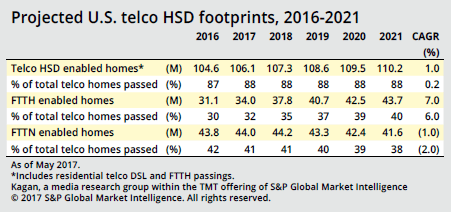
Chart Courtesy of SNL Kagan
………………………………………………………………………………………………..
Wireless-only forecast by SNL Kagan:
The wireless-only segment, i.e., households that use a wireless service as their primary Internet connection, has been kept in check with limited speeds and capacity constraints, but the landscape is expected to change. The opportunity for wireline HSD disruption and accelerated growth in single data services for consumers arrives later in the outlook with the adoption of the 5G platform.
Verizon expects the 5G standard to feature an exponential increase in speed with download speeds of multiple gigabits per second and millisecond latency that will deliver the benefits of fiber to wireless including 4K video streaming.
Verizon said a launch before 2020 is a real possibility based on the wireless industry’s engagement.
In the near term, the top two telcos, AT&T and Verizon, are moving ahead with their network upgrades to 5G. AT&T announced it will begin its transition to 5G in 20 metro areas by the end of 2017 and Verizon said it will deliver 5G services to customers in 11 markets in the first half of 2017.
We anticipate 5G standards to be in place midway through the outlook, with increased adoption of the service picking up in 2020 when the services launches.
AT&T launched its fixed wireless internet service in April. The company said the service will reach 400,000 locations by the end of 2017 and more than 1.1 million by 2020. The service is marketed at $60 per month for 160 GB of data. However, with fixed wireless download speeds initially pegged at 10 Mbps, we expect satellite HSD with its faster speeds to grow faster in rural and unserved areas until fixed wireless speeds increase.
The next generation of technology has the potential to lift wireless-only customers with the draw of improved speeds. However, even with 5G speeds on par or exceeding wireline HSD, we do not see it is a displacement for wireline offerings. We forecast the wireless segment to increase but still represent only a small portion of customers that rely on it solely for broadband access due to bandwidth limitations and a 5G rollout that could favor major metropolitan areas.
Kagan expects the number of households relying solely on wireless HSD connections to increase to 6.4 million by 2021. (To avoid double-counting, our tally excludes customers with wireless connections who also subscribe to wired HSD services.
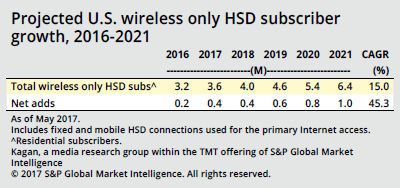
Chart Courtesy of SNL Kagan
………………………………………………………………………………………….


